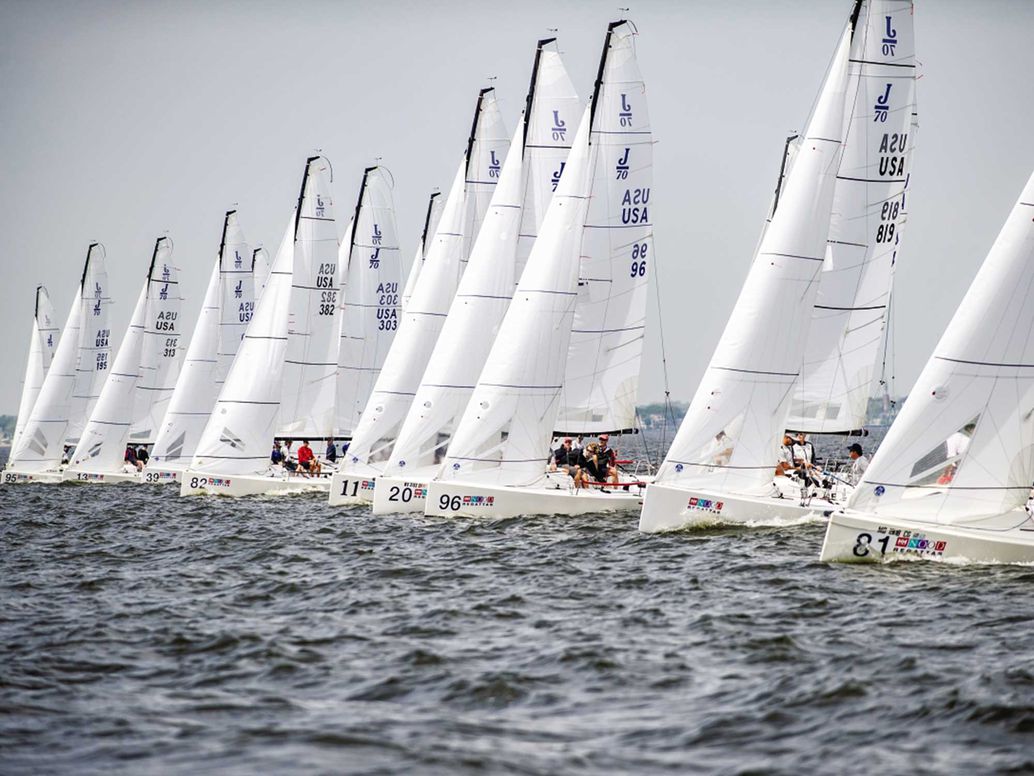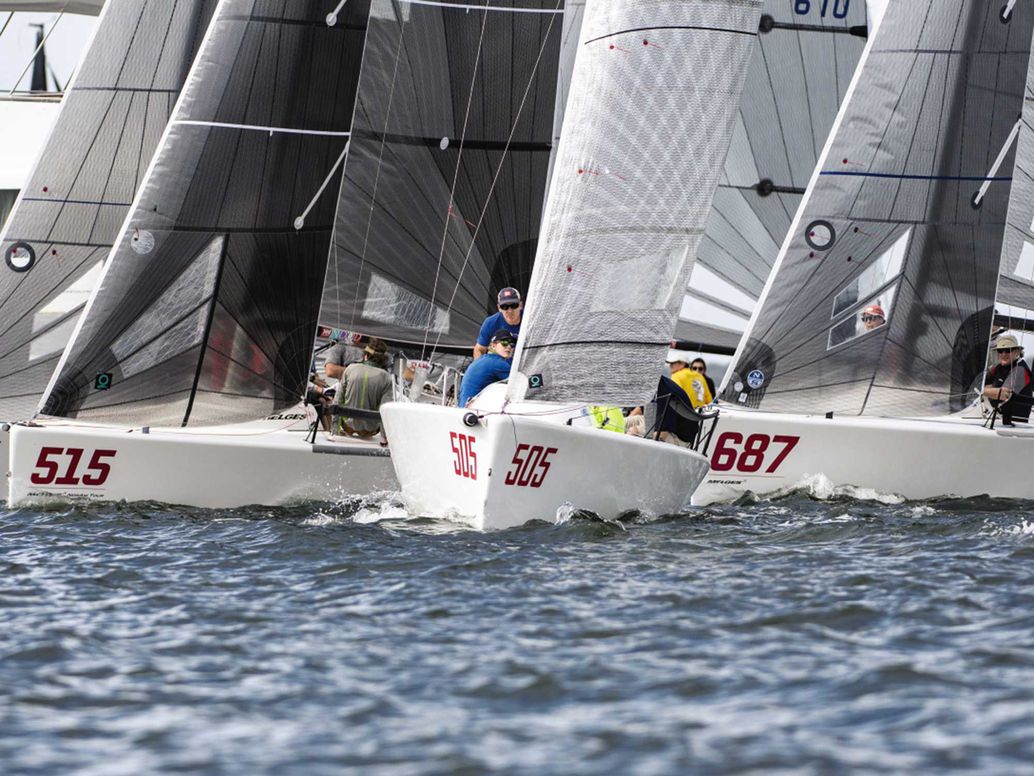A boat that gets off the starting line in a good position and has good upwind speed is probably going to be near the top of the fleet at the first weather mark. That’s easy to say but challenging to do, especially the starting part. However, if you learn to follow a script or plan that makes the starting routine mechanical, you’ll discover that each start becomes better, and your starts, overall, become more consistent. The good news is that plan can be followed wherever you start on the line and whatever the breeze.
How do you know when you’ve managed a good start? Simply put, you’ve gotten off the line in the front row with competitive speed so you can take advantage of the first shift. It’s cool to be able to blast off the line with a boatlength or two lead and have the fleet over your shoulder. But even just one boat hanging on your weather hip eliminates your opportunity to tack on the first header and, as a result, a good start is wasted.
The race committee’s goal is to set a line basically perpendicular to the wind so that no single boat has an advantage, regardless of where it starts. However, the wind almost always shifts, and seemingly does so at the last minute. If the line is fairly short and/or one end is favored by 5 degrees or less, starting in the middle becomes an excellent choice, giving a conservative starter the opportunity to take advantage of a shift from either side of the course. The fastest college sailors often start near the middle of the line, knowing that they can protect the left side of the course or tack and consolidate the right.
However, in big fleets—50 boats or more—or on a line where one end is heavily favored, say, 15 to 20 degrees, then starting closer to the favored end becomes more advantageous. I emphasize closer, as it can be risky to start right at the favored end because everyone’s trying to start there. Starting a third of the way up or down from the favored end is much less risky and can make it easier to get off the line.
Remember, the angle of the wind relative to the starting line determines which end is favored, and unless the course to the first mark is way off square to the wind or the starting line is skewed by more than 30 degrees, the course to the first mark shouldn’t have any effect on where you start.
While there are several different methods in checking which end is favored, unless I am sailing in a small fleet or on a small inland lake, I use the compass. If the line is short and the fleet is small, head into the wind and note which end of the line the bow points closer toward. That’s the favored end. On longer lines with more boats and in more-extreme conditions (very light or very heavy winds), the compass is much more accurate. Take a compass heading while sailing down the line and compare it to your head-to-wind reading. If more or less than 90 degrees (which tells us if the line is square), not only will you know which end is favored, but also how much it’s favored. In addition, once you have the line compass bearing, you can double check which end is favored anytime, anywhere (and away from all the traffic on the line) just by heading into the wind.
If you have GPS technology, ping the ends of the line once the line is set. Luff head-to-wind, close to the committee boat, moving very slowly so it’s easy to get a good reference. At the leeward end, set up outside the line, again head-to-wind and moving slowly, where it’s easy to gauge exactly when on the line. Once you have confidence in your pings lining up, managing the last minute becomes much easier.
Without a GPS (and to double check your GPS settings), rely on line sights. Start at the weather end, on starboard tack, closehauled, loosely trimmed and moving slowly, four to five boatlengths below the line. Start taking line sights with something onshore through the leeward end of the line. Ideally, you’ll have one at four to five lengths, three lengths and two lengths off the line, as well as the final shot right down line. Those early “safe” line sights are crucial in gauging the speed and timing to the line, because invariably the sights down the actual line become tough to maintain in the last 10 seconds, when the fleet is lined up. Sometimes a line sight to weather through the committee boat by the forward crew can be a valuable check in the last 10 to 15 seconds.
Check for current at all spots on the line, recognizing that there could be current at different speeds and different angles at each end. Practice the laylines at each end to gain confidence in the approach angle to the line, and especially where you ideally would want to start. Finally, practice your actual maneuverability and the speed required to maintain control of your boat. It’s important be able to recognize when you are too slow to be able to head up or bear off, even when using your sails to help control the boat.
While many sailors develop a series of different approaches to draw on for starts in different conditions in different size fleets and for different positions on the line, I focus on one approach for every start. Therefore, I know exactly how I’ll set up, no matter where I want to be on the line. The only variable becomes the timing. The two most common approaches are starboard luffing, where boats line up several lengths below the line several minutes before the start, and the port-tack approach, which is my favorite.
With the port-tack approach, come in a boatlength or two below the bulk of the fleet; most boats will be luffing on starboard. Depending on the breeze, the waves and the size of the fleet, I’ll look for and then tack into a hole on the line close to one minute before the start, depending on the conditions and fleet lineup. In some ways, this approach might seem risky because you’re sailing on port tack toward a group of starboard tackers. However, remember that one of the most important goals of the starboard tack boats is to develop a hole to leeward. If this hole is big enough and left open, it’s an open invitation for a port tacker.
One of the keys to a successful port-tack approach is the tack into the vacant hole. This tack should be slow and controlled so that once around and onto starboard, your bow will be slightly behind that of the boat to weather. Speed after the tack should be slow so that you are immediately in a position to become the leeward controlling boat. Leave yourself the opportunity to accelerate and not be dangerously close to the line. This is one of the major differences between the starboard and port-tack approaches. During the port-tack approach, you are attacking the starboard boat’s position, while those using the starboard approach are usually trying to defend.
If you’re the approaching port-tack boat, you must sail all the way through the tack and onto your starboard closehauled course before you can assume your new, leeward boat rights. And you must give the weather boat room and time to fulfill its new obligation to keep clear. Once the port tacker has completed his tack to starboard, the now windward starboard tack boat must begin to keep clear and assume the port tacker has now become the leeward boat with rights.
What if there isn’t a hole at the spot where you want to tack? In that case, you probably wouldn’t want to start in that pileup of boats anyway. Instead, sail down the line a bit farther until a more inviting hole presents itself.
Obviously, the starboard-tack boat will not just sit and wave you on into the hole they have been working hard to create. They should defend by bearing off toward you as you approach. If the hole is small, or the tack from port to starboard becomes rushed, the port tacker most likely will become discouraged with that spot and sail up the line looking for the next hole.
Once you know how you’ll approach the line, the remaining variable is timing. Ideally, you’ve practiced your timing in that five or 10 minutes before the start. When I set up with the port-tack approach, I determine how long it takes to get from the leeward end pin to my spot of choice on the line, unless the line is super long. I sail back and forth several times in order to determine how long it takes, and then add 10 to 15˛seconds for the tack. Usually, I try to complete the tack onto starboard by 55 to 60 seconds before the start, depending on the breeze and the size of the fleet—the lighter the breeze, the lumpier the wave state; the larger the fleet, the earlier the tack. If we know it takes 40 seconds to get to that spot, we’d leave the pin with 1:45 left before the start.
Once in position, control your hole and the boat to windward. This doesn’t demand any sort of attack that requires the use of the rulebook. It requires you to maintain a position where your boat can dictate when the windward boat can trim in and accelerate. Position your bow slightly behind the windward boat’s bow but still in clear air. Your course should be just above closehauled with your sails luffing. Use mainsail trim to help maintain this bow-up position. Try to maintain a boat’s width or slightly less between you and the weather boat. If the weather boat begins to trim and accelerate, trim, gradually head up, and force it to slow down. As long as they’ve been provided the opportunity to keep clear of you, they will also need to luff.
At the same time, work hard to stay off the boat to leeward, if there is one. Constantly watch the leeward boat’s position and speed. If they accelerate and sail higher toward you, react by doing the same to maintain a safe distance—hopefully as much as two to three boat widths. This hole to leeward is key in allowing you to sail slightly below closehauled, in first gear, in order to accelerate in the five to 10 seconds before the gun.
In the last 15 to 20 seconds, the GPS pings and/or line sights are important gauges that will give you confidence in your positioning. Pay close attention to your placement relative to the lineup of boats close by. Especially watch the two to three boats to windward, always trying to maintain the same slight bow-back position throughout the entire starting approach. That will give you a runway to accelerate into so you can begin to trim before the competitors above do. If any of those boats to weather trims and begins to accelerate, trim immediately and match its speed, no matter where it is on the line or the time before the gun. If even one of those boats gets the jump and ends up on your wind after the gun, it can be game over.
One tip is how to slow the boat when you find yourself dangerously close to being over early. Our instinct tells us to turn down, away from the line. However, bearing away usually means burning up the valuable hole to leeward and, in fact, you end up accelerating right into it. Instead, head up to near head-to-wind. The boat will slow more quickly and slow the weather competitors. You’ll buy more time and save distance to the line. Most important, you’ll build the hole to leeward and close the distance to windward.
Especially for the first minute after the start, boatspeed is king. Fight the urge to point as high as possible until the boat has sailed through all the gears and is at top speed. Definitely do not pinch. A common mistake is to trim the sails too tightly, too quickly. If the sails are trimmed right to the closehauled position before the boat has the time to sail through the gears, the boat will load up and slide sideways. Talk about burning up the hole to leeward!
On our boat, we divide all the responsibilities where, in the last 15 seconds, I am simply steering when and where the crew indicates. If we’re sailing with three, the jib trimmer keeps track of the line and our position relative to the boats to weather. That person has control of our final timing and dictates exactly when to pull the trigger. The middle person keeps the time and looks aft and to leeward for boats approaching late on port or behind and low on starboard. Our boat is anything but quiet in these last seconds, but this constant influx of information allows me to concentrate entirely on boatspeed.


